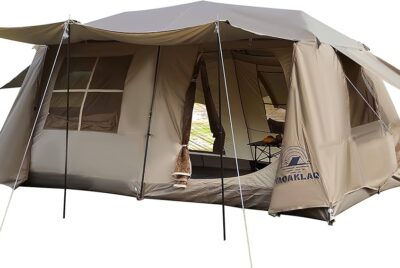Your Ultimate Guide to Inflatable Camping Tents
Introduction:
Embarking on a camping adventure brings a sense of excitement and connection with nature. If you’re venturing into the camping realm, the choice of your shelter is paramount. Enter the inflatable camping tent, a game-changing innovation that marries convenience with comfort. In this comprehensive guide, we’ll explore the ins and outs of inflatable camping tents, providing essential insights for both beginners and seasoned campers alike.
Why Inflatable Camping Tents?
Camping novices might wonder, why choose an inflatable tent? The answer lies in the effortless setup. Unlike traditional tents that demand a complex assembly of poles and stakes, inflatable tents utilize air-filled beams to structure the tent. This not only slashes setup time but also minimizes the potential for frustration, making it an ideal choice for those new to the camping scene.
The Science Behind Inflatable Tents: How Do They Work?
Inflatable tents operate on a straightforward yet ingenious principle, replacing traditional poles with air-filled beams to provide structure and stability. Typically crafted from durable materials like TPU or PVC, these air beams outline the tent’s framework. Setting up an inflatable tent involves using a pump to fill these beams with air, transforming them into rigid and sturdy supports for the tent fabric. The design not only simplifies the setup process but also enhances the tent’s ability to withstand various weather conditions. This innovative technology ensures that campers can enjoy a reliable and comfortable shelter without the complexities of traditional pole assembly.
Advantages of Inflatable Camping Tents:
Rapid Setup:
The efficiency of setting up an inflatable tent surpasses that of traditional tents, marking a significant advantage for campers. The absence of complex pole systems simplifies the process, and with inflatable tents, campers can expect a rapid setup with minimal effort. Instead of threading poles through sleeves and securing multiple stakes, users only need to inflate the air beams using a pump, drastically reducing the time required for assembly. This streamlined setup not only saves valuable camping time but also eliminates potential frustrations associated with traditional tent pitching. Inflatable tents offer a hassle-free and swift solution for those who prioritize a quick and easy camping experience.
Compact and Portable:
Inflatable tents offer a game-changing advantage in terms of portability and compactness. When deflated, these tents pack down to a fraction of the size of traditional tents, making them exceptionally easy to transport. The absence of bulky and cumbersome poles contributes to the compact profile, allowing campers to optimize space in their vehicles. This advantage is particularly appealing to those who are constantly on the move, whether embarking on a road trip or exploring various campsites. The compact and portable nature of inflatable tents not only enhances convenience but also makes them an ideal choice for adventurers who prioritize versatility in their camping gear.
Sturdy in Windy Conditions:
The robust design of inflatable tents makes them particularly adept at withstanding windy conditions. Unlike traditional tents with rigid poles that can be prone to bending or breaking in strong winds, inflatable tents utilize flexible air-filled beams. These beams act as shock absorbers, allowing the tent to flex and adapt to gusty winds rather than resisting them. The result is a more wind-resistant structure that can withstand challenging weather conditions. Additionally, many inflatable tents are designed with aerodynamics in mind, reducing wind resistance and enhancing stability. Campers can rest assured that their inflatable tent will stand strong, providing a secure and comfortable shelter even in blustery conditions.
Comfortable and Spacious:
Inflatable tents redefine camping comfort with their spacious and well-designed interiors. The air-filled beams not only provide structural stability but also allow for a more upright and vertical wall design. This innovation translates to increased headroom and a sense of spaciousness inside the tent. Campers can move around comfortably without feeling confined, creating a more enjoyable living space. The generous dimensions of inflatable tents are especially appreciated during extended trips, providing room for gear storage and allowing campers to relax without the cramped quarters often associated with traditional tents. The combination of structural integrity and thoughtful design makes inflatable tents a compelling choice for those seeking both comfort and space in their outdoor accommodations.
Choosing the Right Inflatable Camping Tent:
Size Matters:
Size is a crucial consideration when it comes to inflatable tents, directly impacting the comfort and functionality of your camping experience. Choosing the right size ensures that the tent accommodates your camping group comfortably and provides ample space for gear. Too small, and you risk feeling cramped; too large, and you might struggle with unnecessary setup complexity. Additionally, larger inflatable tents may require more time and effort to inflate fully. Understanding the dimensions that suit your needs ensures a harmonious camping setup, optimizing both living space and ease of use in your inflatable tent adventure.
Weather Resistance:
Inflatable tents boast impressive resistance to adverse weather conditions, making them a resilient choice for outdoor enthusiasts. Constructed with durable materials like TPU or PVC, these tents can withstand the elements, including rain and wind. The air-filled beams that structure the tent provide flexibility in the face of strong winds, reducing the risk of damage compared to traditional pole systems. Many inflatable tents also come equipped with weather-resistant features such as reinforced seams and a robust rainfly, ensuring a dry and secure shelter even in challenging conditions. This resilience makes inflatable tents a reliable option for campers who venture into diverse and unpredictable weather scenarios.
Ease of Inflation:
Inflating an inflatable tent is a remarkably straightforward and user-friendly process, contributing to the appeal of these tents for campers seeking convenience. Typically, the tent comes with a manual or electric pump that connects to the air beams. With a few simple steps, users can swiftly inflate the tent by pumping air into the beams. The absence of complex pole systems eliminates the need for intricate assembly, reducing the setup time significantly. Even for those new to camping, the ease of inflating an inflatable tent ensures a stress-free and enjoyable experience, allowing campers to focus on the adventure rather than grappling with setup complexities.
Maintenance and Care:
Maintaining an inflatable tent involves a few simple yet crucial steps to ensure longevity and optimal performance. Regularly inspect the tent for any punctures, paying close attention to the air beams. Most inflatable tents come with a repair kit, enabling quick fixes for minor damages. When packing up, ensure the tent is dry to prevent mold or mildew growth. A groundsheet under the tent protects against sharp objects on the ground. It’s advisable to store the tent in a cool, dry place when not in use. By adhering to these maintenance practices, campers can extend the lifespan of their inflatable tent, ensuring it remains a reliable and durable shelter for many outdoor adventures.
Conclusion:
Inflatable camping tents have revolutionized the camping experience, offering a blend of convenience and comfort that appeals to both new and seasoned campers. The swift setup, compact portability, and sturdy design make them an excellent choice for those looking to immerse themselves in the beauty of nature without the hassle of traditional tent assembly. As you embark on your camping journey, consider the advantages of inflatable tents and the factors that go into choosing the right one for your adventure.
FAQs:
How durable are inflatable camping tents?
Inflatable tents are designed with durability in mind, often using robust materials like TPU or PVC for the air beams. Regular maintenance, such as checking for leaks and using a groundsheet, enhances their lifespan.
Are inflatable tents suitable for all weather conditions?
Many inflatable tents are designed to withstand various weather conditions, including rain and wind. It’s crucial to choose a tent with appropriate weather-resistant features and use a rainfly for added protection.
Can inflatable tents be repaired if punctured?
Yes, inflatable tents can be repaired if punctured. Most tents come with a repair kit that includes patches for quick fixes. Regularly check for punctures and address them promptly to maintain the tent’s integrity.
How long does it take to inflate an inflatable camping tent?
The time to inflate a tent varies based on the tent size and the type of pump used. In general, inflatable tents can be fully inflated within 5 to 15 minutes, providing a quick and hassle-free setup.
Are inflatable tents suitable for backpacking?
While inflatable tents offer portability, they might not be the best choice for backpacking due to their weight and bulkiness when packed. They are more suitable for car camping or short-distance hikes to the campsite.




